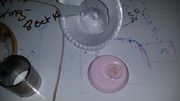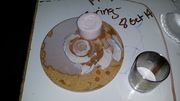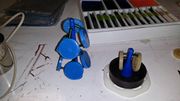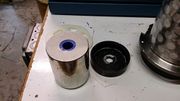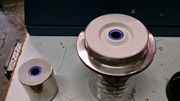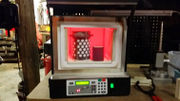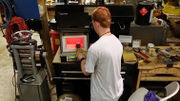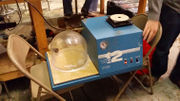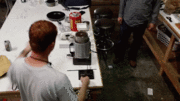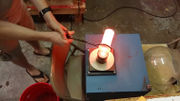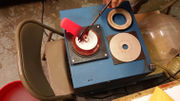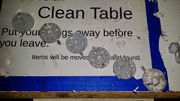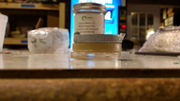Lost Wax Casting
From Makers Local 256
|
Creator: |
Contents
Overview
I've been meaning to learn how the vacuum chamber is used in jewelry casting for a while now. I got Lowell to show me how.
Steps
Make a Model
(Original-positive)
- For this step I decided to do it the easy way and made an acrylic disc, the plan being that it will be no bigger around than a silver dollar coin, though I am using thick acrylic to lower the chance of the aluminium failing to fill all of the voids.
- I went to wikipedia and found the diameter of a silver dollar coin and multiplied it by 1.05 (to account for shrinkage in the molds) and scaled an old Maker-logo-coin svg image that i had made for an event a year or two ago. I also scaled up the thickness of the wrench to allow for a wider cut and scaled the bolt that the wrench is grabbing as well.
- I raster the acrylic and then vector cut the circle, while skipping the logo in vector mode.
Cast a Silicon Mold
(Silicone-negative)
- I used this kit for the mold. The mixing directions are straightforward and they include measuring thimbles. CLEAN UP WITH MINERAL SPIRITS. SOAP MAKES A MESS. I wound up using about 8oz if the 16oz that I bought for this project. see pic to get an idea of the volume.
- The mix is 1 thimble of hardener for every 2 tablespoons of rubber or a 1:10 ratio.
- I mixed it in a styrofoam cup, so its not reactive to styrofoam.
- I hotglued the acrylic model to the bottom of a styrofoam bowl and poured the rubber in over it. Cure time is 18 hours.
Cast wax
(Wax-positive)
- I used Two different approaches for this. The first was to use the Wax I've used in the past, a high melting temp, extra hard candle wax, that I'd mixed with some spent scented wax. The other wax was jeweler's carving wax, which has a plastic polymer that makes it machinable.
- The paraffin wax took the mold well, bubbles were pushed out with a chopstick.
- The carving wax was much too dense, even after melting, to take the finer design components. I wound up diluting it with the paraffin wax (about 1:1) before I was able to get good resolution.
- Another issue with the carving wax was that is started burning soon after melting, so that complicated experimentation as well, I really should invest in a double boiler if I plan to do this a lot.
Sprue Tree
- I used a wax pen to attach the wax positives to the sprue tree. The process is relatively simple though it is important to remember to put the details at the top (because the tree will be upside-down at the time of the casting).
- Keep in mind that what is wax, at this stage will be an air pocket in plaster, after the burnout, so plan Two paths out, otherwise pockets will develop.
Investment Mixing/Casting
(Plaster-negative)
- As with the wax positives, I also experimented with Two different investment plasters. The first was Ultracal, a plaster specially formulated for metal casting. The other was Ultravest, an investment plaster for jewelry.
- The mixing recipe I used was the same for both, the only difference was the volume of the two containers (the paraffin wax disks used a smaller investment flask.
- Determine the volume in cubic inches of the investment flask. (V=π*r^2*h)
- Multiply Volume by 0.0455 inches^3/lb to get the weight of plaster to mix
- Multiply Volume by 0.272 inches^3/oz to get the water to mix
- as with all plaster, MIX PLASTER INTO WATER, NOT WATER INTO PLASTER.
- hand mix for 30 seconds
- mechanically mix for 3 minutes
- Vacuum the investment until it rises and breaks, do not exceed 2 Minutes. Skipping this step can be hilarious.
- Pour the investment into the the flask up to the top of the wax tree
- Vacuum the flask for about 90 seconds. (I had to give it breaks to get the investment to stop bubbling, but it settled down after a couple of minutes)
- Top off the flask with the remainder of the investment
- Allow to cure for 2 hours
- Remove the sprue base and any flask heatshrink
Kiln Firing
- Kiln firing is dependent on the volume of the flasks being fired
| Up to 50"^3 | Up to 113"^3 | Up to 340"^3 |
|---|---|---|
| melt out wax for 2 hours (300F) | melt out wax for 3 hours (300F) | melt out wax for 4 hours (300F) |
| burnout at 1350F, at a 5 hour ramp, hold for 2 hours | burnout at 1350F, at a 6 hour ramp, hold for 3 hours | burnout at 1350F, at a 7 hour ramp, hold for 4 hours |
| reduce to cast temp and hold for 1 hour | reduce to cast temp and hold for 2 hour | reduce to cast temp and hold for 3 hour |
- I recovered the wax from the first step by putting a metal pan in the bottom of the kiln to catch the drippings and ran the first stage with the flasks upside-down so they could drain.
Pouring Metal
(Metal-positive)
- This used the investment vacuum to aid in metal flow
- Melt Metal in crucible
- Pull flask out of kiln, place it in/on vacuum
- Pour the metal in to the flask as quickly as possible, without spilling!
- Allow the metal to cool before dropping the flask in the water bucket
- Caution, the investment can cause the water to froth violently
| Original Diameter | 39.32 mm |
| Wax Diameter | 38.49 mm |
| Aluminium Diameter | 37.41 mm |
| Copper Diameter | 37.74 mm |
More pics here.

